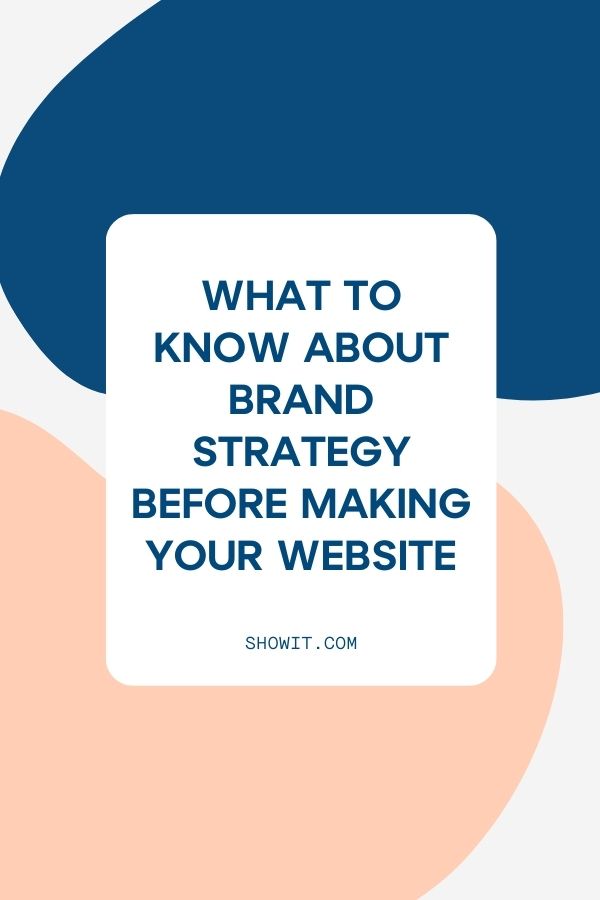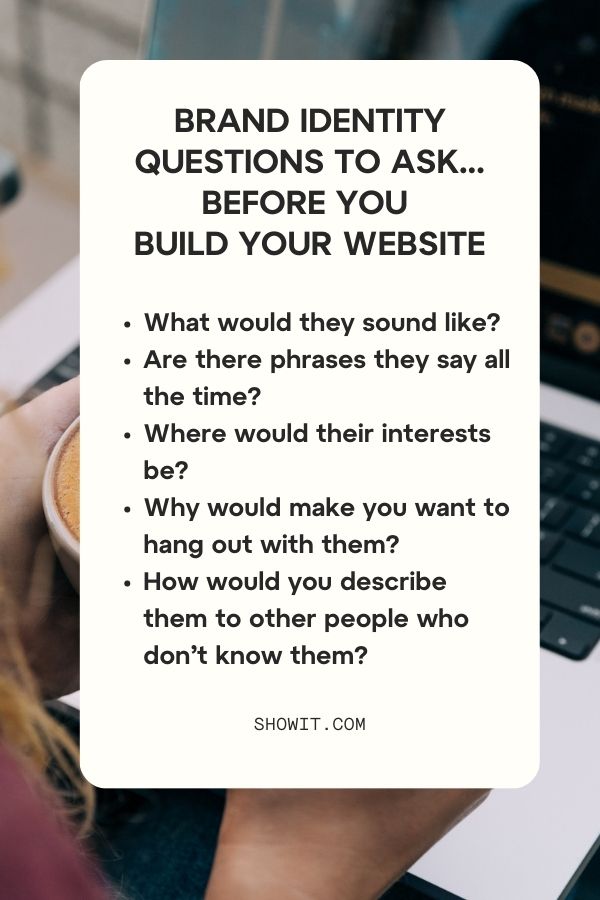Welcome back to Showit’s Website Health Series! We’re sharing all of our best tips and tricks for building an easy-to-find, easy-to-love website that your audience won’t be able to get enough of! If you wanna start in the beginning, you can do so with the Website Check-Up.
But before we can get into any of that, there’s one essential puzzle piece you’ll need to develop for your business first:
A brand strategy.

What is a brand?
To put it simply: your brand is your imprint. It’s the mark you leave inside people when they interact with you. It’s the feeling you give people; the reason why they choose YOU over your competition.
Your brand is an extension of your identity—and having clarity about that identity is key.
Do you know who you are at your core? Are you in a place where you have a deep understanding of who your target audience is at their core? These understandings allow you to better align yourself as the solution to their problems.
This understanding makes it easier for you to create a strategy to set the expectation that you are the best option for your audience. It will also be easier to showcase how the product or service you’re offering can help your audience overcome the obstacles to their goals.

What is brand strategy?
Everyone knows you need to have a high-converting website, and content that performs well, and a great service to offer. But outside of the huge corporations, small businesses don't realize the importance of a solid brand to ensure the success of your business.
And developing a strong brand strategy—aka the voice, identity, values, aesthetic, and overall messaging—will serve as the backbone for how you’re going to communicate with your community.
By having a brand strategy in place, you (and your team, if you’ve got one!) will never have to worry about maintaining consistency, in terms of brand voice, marketing efforts, or goals. Won't that be the gift that keeps on giving!?!
Your brand strategy is the foundation of who your business IS at its core, so developing it prior to creating any large, lasting projects—hello, website!—is essential. Now that you know it's importance, let's dive in!
10 questions to ask yourself before creating your brand strategy: how to clarify your identity as a brand
#1: WHAT’S YOUR MESSAGE?
How are you bringing a unique solution to a situation? How is that unique solution “good news” to people who have that problem you are trying to solve?
Understanding your message means understanding your “why”—with an added element of considering the following “HOW” piece.
Which problem are you solving? And how is the way that YOU plan to solve it so unique?
By considering not only which solution you’re providing but also how you plan to set yourself apart, you’re able to identify what your “good news” is that you can bring to your audience.
So, that’s why it’s important to consider…
#2: WHAT MAKES YOU DIFFERENT?
Everyone has that “thing” that makes them stand out, even if it’s not immediately clear the first time you sit down to craft your brand strategy.
Have you repeatedly…
- Snagged professional experience that makes you uniquely qualified to offer a specific service.
- Been involved in your industry since the beginning of time, and you’re the authority on the subject.
- Worked on projects that bring a fresh new perspective to your industry.
- Impressed people with the speed in which execute your craft.
- Made your clients feel comfortable, supported, and appreciated.
- Approached your client work like you’re completing it for a loved one, and always end your projects with great testimonials and great friends.
Whatever that thing may be, finding it is key—and remembering that you can always change it, tweak it, and update it to reflect new experiences is key, too.
If you’re unsure of how to find it, we recommend asking your friends, family, coworkers, or past clients; you’ll be surprised how helpful your community can be when looking inward isn’t as effective as you’d hoped.
#3: HOW CAN YOU COMMUNICATE YOUR DIFFERENTIATOR?
Before creating your brand strategy—and then creating all of the content that strategy will then inform—you’ll need to get comfortable with communicating your differentiator; with telling (or showing!) people what makes you stand out.
Spend a bit of time stalking your competitors to see if you can easily identify what makes them different from the rest of the crowd, and look for a potential blind spot.
“Did anyone else mention client experience?”
“How come no one’s talking about the support they offer *after* the service they provide?”
“Is there anyone else who puts as much of an emphasis on research as I do?”
You may also find it helpful to check out other brands in completely different industries to see the ways they communicate their differentiators, as inspiration for how you can share yours with the world!
#4: WHAT IS THE PROMISE YOU’RE MAKING TO YOUR IDEAL CLIENT?
An extremely vital element of your brand strategy to develop is the exact promise you’re planning on making to your ideal client, and why you’re committed to making that promise (or providing that solution).
With a clear definition of how you plan to serve your audience, it’ll be so much easier for you to communicate your value, stay on top of your goals, and ensure that every element of your marketing is aligned with what you’ve set out to do for your community.
#5: AT WHICH POINT DO YOU ENTER THEIR STORY?
Knowing where you enter the scene for your ideal client is SO important when crafting your brand strategy, because it allows you to interject yourself at the perfect time.
It also helps you determine which information is relevant to share with someone, and at which point of the process you should do so.
For example: If you’re a website designer, and you’re targeting people who have been in business for a while, and are creating their second website, you probably don’t need to spend time educating them about what website design is.
Instead, you’d want to spend your time educating them about why you are the right website designer for them (or, say, why Showit is the best website hosting platform for creatives.😉)

#6: HOW CAN YOU MAKE YOUR IDEAL CLIENT’S LIFE BETTER?
Outlining the specific ways in which you can improve your ideal clients’ current situations is a great way to learn more about the role your brand plays in their story, as well as how to position yourself in your marketing to attract the right people.
Think about what happens after you work together, and the results you’re able to provide for them. How can you use this information to inform the way you present yourself (and market to!) potential new clients?
#7: WHAT KIND OF ADDED VALUE DOES YOUR BRAND BRING?
What does your brand bring to your clients that adds value to their lives?
Is there a specific way you approach offering your services? Is there an added personal touch involved in your client experience? Is there a unique element of your process that your current clients extra appreciate?
Consider what makes your clients love you—and infuse that into your brand strategy.
#8: WHAT IS YOUR BRAND’S PERSONALITY?
We know, that’s a big decision to make. And we agree that this is one of the most complex questions on this list—but think about it this way: what if your brand were a friend of yours?
What would they sound like? Are there phrases they say all the time?
Where would their interests be?
What would make you want to hang out with them?
How would you describe them to other people who don’t know them?

Brands that have recognizable personalities—shown through their aesthetic, their brand voice, and their consistent core messaging—are proven to be sooo much more recognizable to their communities, and, in turn, garner much more engaged (and loyal) followings.
Spend this time developing your brand strategy thinking about the kind of persona your target audience would resonate with most, while still remaining authentic to you & your business goals.
#9: WHAT’S THE MAIN THING YOU WANT YOUR COMMUNITY TO KNOW ABOUT YOU?
Considering what you want your community’s impression of you to be is such a huge help in determining how you want your brand to sound, the words and phrases you use, and the tone of your voice.
If you want to be seen as a reassuring presence, you’re not going to pick an irreverent brand voice.
If you want to be seen as a fun, friendly presence, you’re not going to use a strictly professional, un-conversational tone.
Once you decide how you want to be perceived, your decision about what kind of messaging to use for your brand gets so much more clear.
#10: HOW DO YOU WANT TO MAKE PEOPLE FEEL WHEN THEY INTERACT WITH YOUR BRAND?
As a business owner with an online presence, first impressions will likely happen for you daily—how do you want people to feel when they encounter you online for the first time?
Thinking about the feelings you evoke in someone is another great way to determine your values, your voice, and your core message.
5 questions to help you clarify the role you play in your target audience’s story

Now that you know who YOU are at your core, you’ll need to explore who your ideal client is at THEIR core, so you can ensure that you’re the perfect person to help provide them with the exact solution they’re looking for.
Getting clear on exactly what you’re providing them with, how it’s helping them, and why they need what you’re offering will inform every single part of your brand’s strategy, from which keywords you research during your SEO efforts, the copy you write for your website, the content you create for your marketing channels… all of it.
#1 – WHAT DOES MY IDEAL CLIENT NEED ME FOR, AND WHY?
Figuring out which challenges your ideal clients are facing will be the easiest way for you to determine how to frame the help you’re planning on providing them.
Starting with the end result, and working backwards to understand the “why” behind their decision to work with you, is a great way to get some necessary insight into what your target audience may need to know in order to make a buying decision.
#2 – WHAT’S THE *REAL* REASON THEY’RE SEEKING HELP FROM ME?
Of course, your ideal clients are interested in the services you’re offering, but their desires don’t stop there. There’s always a reason why they want that thing—and that’s what you’ll want to focus on.
The Ask: a family photo session. The Why: They want preserved memories of their toddlers splashing around at their favorite beach.
The Ask: a cool new website. The Why: They want a design that reflects exactly who they are as a brand so they can attract people who respect them (and finally stop working for people who don’t value what they do).
The Ask: advice from a money coach. The Why: They want to feel confident in their finances for the first time in their life, so they don’t have to choose between a family vacation and sending their kids to college.

You see where we’re going with this? Getting to the core of what your target audience ACTUALLY wants—not just the surface-level reason they need the service—helps you write stronger copy, portray a more meaningful message, and build better connections with your audience.
You’ll also want to consider what their current life situation is, what their stage of awareness is, and how much value they place on the service you’re offering, so you can discern how urgent their need for your help is—and how much they’re willing to invest in it.
#3 – WHAT DO THEY GAIN FROM WORKING WITH ME?
The oldest copywriting trick in the book is sharing the benefits before the features of a given service or product, which is why starting with what your audience can GAIN when working with you is the smartest approach to take to crafting messaging around what makes you and your brand so worth it.
When developing your target audience, think of all the positive outcomes you can provide for them—and how they’d respond to learning that you’re able to meet their needs.
#4 – WHAT DOES MY TARGET AUDIENCE SOUND LIKE?
Which words or phrases do they use all the time? How do they speak to their friends and peers? Which industry terms are they familiar with, vs. not?
Considering how your ideal clients sound is an important element of your target audience development, because you can’t effectively communicate with them if you don’t know how to speak their language.
#5 – WHAT ARE THEIR DEMOGRAPHICS?
Finally, you’ll need to think about which age group, gender identity, and location you’re targeting, as well as potentially even their lifestyle, socioeconomic status, interests, activities, motivations, and priorities, depending on the type of service you’re offering.
Getting to know your target audience as thoroughly as possible is always a good idea before crafting any kind of content or creating a lasting strategy for your brand, because the more you know about them, the easier it’ll be to market to them.

The 1 question you need to ask yourself about brand strategy before creating your website
Do you feel confident in what you’ve created for your brand?
If your answer is “yes”—perfect.
We’re going to spend the next 8 posts in this series teaching you everything you need to know about building a website that works for you, creating content that your ideal client will love, and how to inspire your audience to take action.
If your answer is “no”—that’s okay!
That simply means you still have a little bit of work to do, and we can help with that, too.
Check out our other brand strategy resources here! 👇
How To Create A Simplified Brand Strategy
3 Simple Steps to Boost your Brand Authority
If you feel confident and want to learn more, check out post 3 in this series which is all about mistakes to avoid when making your website.

